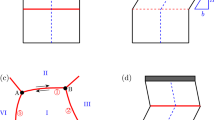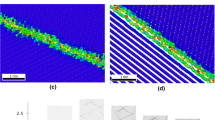Abstract
We study the process of grain boundary sliding through the motion of grain boundary dislocations, utilizing molecular dynamics and embedded atom method (EAM) interatomic potentials. For a Σ = 5 [001]{310} symmetrical tilt boundary in bcc Fe, the sliding process was found to occur through the nucleation and glide of partial grain boundary dislocations, with a secondary grain boundary structure playing an important role in the sliding process. While the homogeneous nucleation of these grain boundary dislocations requires shear strain levels higher than 7%, preexisting grain boundary dislocations are shown to glide at applied shear levels of 1.5%. The glide of the dislocations results in coupled motion of the boundary in the directions parallel and perpendicular to itself. Finally, interstitial impurities and vacancies were introduced in the grain boundary to study the effects on the sliding resistance of the boundary. While vacancies and H interstitials act as preferred nucleation sites, C interstitials do not. Both hydrogen and C interstitials stop dislocation glide whereas vacancies do not. A detailed study of the dynamic properties of these dislocations is also presented.








Similar content being viewed by others
References
Van Swygenhoven H, Caro A Farkas D (2001) Scr Materialia 44(8–9):1513
Pond RC, Hirth JP (1994) Solid State Physics – Adv Res Appl 47:287
Van Swygenhoven H, Derlet PA (2001) Phys Rev B 64(22)
Hoagland RG, Kurtz R (2002) Philos Mag A – Phy Cond Matter Struct Defects Mech Prop 82(6):1073
Farkas D, Curtin WA (2005) MSE&A 412(1–2):316
Winning M (2004) Zeitschrift Fur Metallkunde 95(4):233
Kurtz RJ, Hoagland R, Hirth JP (1999) Philos Mag A – Phy Cond Matter Struct Defects Mech Prop 79(3):665
Sheikh Ali AD (1997) Acta Mater 45(8):3109
Sagalowic L, Clark WAT (1996) Interface Sci 4(1–2):29
Bollmann W (1981) Philos Mag A – Phy Cond Matter Struct Defects Mech Prop 43:201
Sansoz F, Molinari JF (2005) Acta Mater 53(7):1931
Dorfman S, Fuks D, Malbouisson LAC, et al (2003) Computational Mater Sci 27(1–2):199
Chandra N, Dang P (1999) J Mater Sci 34(4):655
Bishop GH Jr, Harrison R, Kwok T, Yip S (1982) J Appl Phys 53:5596
King TAH, Smith DA (1980) Acta Crystallogr A 36:335
Wang GJ, Sutton AP, Vitek V (1984) Acta Metallurgica 32(7):1093
Hyde B, Farkas D (2005) Philos Mag 85(32):3795
Geng WT, Freeman AJ, Wu R, Geller CB, Raynolds JE (1999) Phys Rev B 60:7149
Ballo P, Degmova J, Slugen V (2005) Phys Rev B 72(6)
Simonelli G, Pasianot R, Savino EJ (1993) Mater Res Soc 291:567
Ruda M, Farkas D, Abriata J (2002) Scr Materialia 46(5):349
Ruda M, Farkas D, Abriata J (1996) Phy Rev B 54(14):9765
Campbell GH, Kumar M, King WE, et al (2002) Philos Mag A – Phy Cond Matter Struct Defects Mech Prop 82(8):1573
Latapie A, Farkas D (2003) Scr Materialia 48(5):611
Chang JP, Bulatov VV, Yip S (1999) J Computer – Aided Mater Design 6(2–3):165
Chang JP, Bulatov VV, et al (2001) MSE&A 309:160
Cahn JW, Mishin Y, Suzuki A (2006) Philos Mag 86:3965
Acknowledgements
This work was supported by NSF, Materials Theory.
Author information
Authors and Affiliations
Corresponding author
Rights and permissions
About this article
Cite this article
Monk, J., Hyde, B. & Farkas, D. The role of partial grain boundary dislocations in grain boundary sliding and coupled grain boundary motion. J Mater Sci 41, 7741–7746 (2006). https://doi.org/10.1007/s10853-006-0552-3
Received:
Accepted:
Published:
Issue Date:
DOI: https://doi.org/10.1007/s10853-006-0552-3




